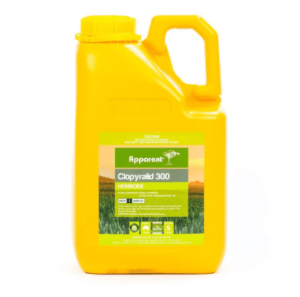Weeds, especially broadleaf varieties like thistles, capeweed, silver wattle, and volunteer legumes, can quickly take over paddocks, pastures, or even residential gardens. Pulling them by hand is labour‐intensive and often ineffective; many return from roots or seed banks. What’s more, weeds rob valuable nutrients and moisture from the soil and compete with desirable plants for light.
If you’re after a reliable, powerful, yet grass‑friendly solution to get broadleaf weeds under control, whether for commercial acreage, farm, industrial land, or a big residential block, CLOPYRALID 300 Herbicide could be the product you need.
In this article, we explore:
What is CLOPYRALID 300?
What Weeds Does It Target
Application Rates & Best Practices
Safety, Environmental & Regulatory Notes
Advantages & Limitations
How to Choose Between the 20 L & Smaller Sizes
About Garden Nursery Products

Active Ingredient: 300 g/L Clopyralid (triisopropanolamine salt).
Type of Herbicide: A selective, systemic herbicide in Group I. It’s designed to be grass‑friendly while targeting certain broadleaf weeds.
Available Sizes: Comes in 5 L and 20 L containers, with the 20 L size suited for larger scale applications.
CLOPYRALID 300 is effective against a wide range of broadleaf weeds including:
Various thistles (Scotch, Spear, Nodding, Variegated, etc.)
Capeweed, skeleton weed, prickly lettuce, volunteer legumes etc.
Silver wattle (in certain foliar or boom spray situations)
Typical use situations include:
Pastures, fallow land, forest edges, and industrial areas.
Areas with rights‑of‑way, fence lines, or areas where broadleaf weed invasion is heavy.
Agricultural land (wheat, barley, oats, triticale, canola) for weed control without harming the grasses.
Rates can vary depending on the weed species, size, growth stage, and method of application (handgun, boom spray, etc.).
Typical example: Handgun general use might be somewhere in the ballpark of 250 mL to 3.3 L per 100 L water; boom spray might be 50 mL to several litres per hectare, depending on severity.
Apply when weeds are actively growing (not dormant or under drought stress). Early‐morning or cooler part of the day often works better.
Ensure good coverage of leaves, stems. Use quality spray equipment (appropriate nozzles, pressure, droplet size).
CLOPYRALID is a professional product, registered by the APVMA (Australian Pesticides and Veterinary Medicines Authority).
Always read the label’s Directions for Use and Safety Data Sheet (SDS). Use protective gear: gloves, eye protection, etc.
Beware of drift onto non‑target plants. It’s selective, but desirable broadleaf plants can still be affected if sprayed incorrectly.
Be aware of withholding periods (e.g. grazing, cut for stock food) and planting restrictions for sensitive crops.
Environmental care: avoid run‑off or spray drift into waterways. Consider the effect on compost; clopyralid residues can persist in plant material and compost.
Advantages:
Very effective on tough broadleaf weeds, especially thistles, when grasses need to be preserved.
Provides long‑lasting control.
Flexible application sizes and methods.
Limitations:
Not a “quick fix” for very large weeds or woody shrubs beyond certain sizes without sufficient coverage or possibly repeated applications.
Residual effects: sensitivity with some future planting of broadleaf crops or legumes.
Risk of damage to non‑target broadleaf desirable plants.
If your weed problem covers many hectares (e.g. paddocks, rights‑of‑way, large industrial sites), the 20 L size gives better cost per litre and fewer refills.
For smaller jobs (e.g. spot spraying, small pasture sections, home garden), the 5 L size is more manageable, less waste, and easier handling.
Also consider storage: the larger size needs safe, secure storage under the regulations.
Garden Nursery Products is a family‑owned business with over 45 years of experience serving the Gold Coast region. We offer a range of herbicides, pesticides, fungicides, fertilisers, and general horticultural supplies. If you are looking for gardening supplies on the Gold Coast, visit our store or shop online.
Added to cart
Check out our shop to see what's available